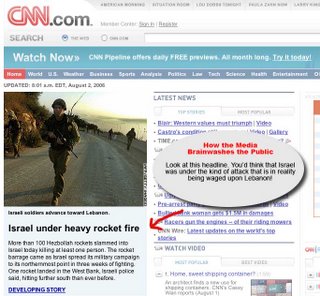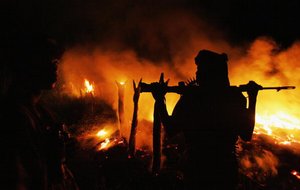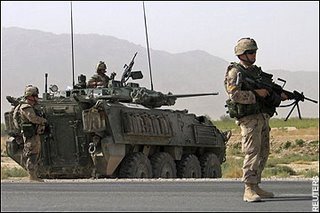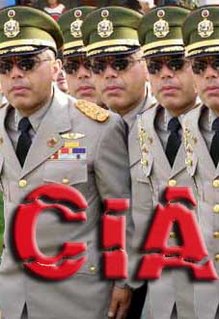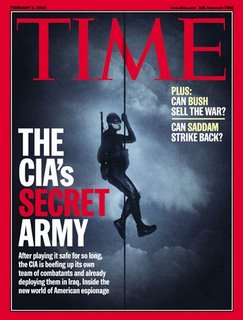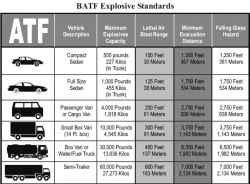
"Return To Sender" (Car Bombs, Part 2)
*************************************************
Courtesy Of: TomDispatch.com
Compiled and Edited By Tom Engelhardt
By Mike Davis
Posted April 14, 2006
At 1:33 am
In the first part of his unique history of the car bomb,
"The Poor Man's Air Force," Mike Davis (author of the only significant book on the Avian flu,
The Monster at Our Door, and
Planet of Slums, a startling analysis of the way significant parts of our planet have been rapidly urbanizing and de-industrializing all at once) took us up through a crucial moment in 1984. It was then that Hezbollah sent the Reagan administration into flight in Lebanon with its massive suicide car bombings and perhaps altered the state of our planet forever. In the second part of his history, we enter a "return to sender" world in which the sponsorship of "surrogate terrorism" blows back all over the globe and the car bomb becomes a near universal weapon of destruction. Tom
Car Bombs with WingsA History of the Car Bomb (Part 2)By Mike Davis
The CIA's Car Bomb University (the 1980s):
"The CIA officers that Yousef worked with closely impressed upon him one rule: never use the terms sabotage or assassination when speaking with visiting congressmen."
-- Steve Coll, Ghost Wars
Gunboat diplomacy had been defeated by car bombs in Lebanon, but the Reagan administration and, above all, CIA Director William Casey were left thirsting for revenge against Hezbollah. "Finally in 1985," according to the Washington Post's Bob Woodward in Veil, his book on Casey's career, "he worked out with the Saudis a plan to use a car bomb to kill [Hezbollah leader] Sheikh Fadlallah who they determined was one of the people behind, not only the Marine barracks, but was involved in the taking of American hostages in Beirut… It was Casey on his own, saying, ‘I‘m going to solve the big problem by essentially getting tougher or as tough as the terrorists in using their weapon -- the car bomb.'"
The CIA's own operatives, however, proved incapable of carrying out the bombing, so Casey subcontracted the operation to Lebanese agents led by a former British SAS officer and financed by Saudi Ambassador Prince Bandar. In March 1984, a large car bomb was detonated about 50 yards from Sheikh Fadlallah's house in Bir El-Abed, a crowded Shiite neighborhood in southern Beirut. The sheikh wasn't harmed, but 80 innocent neighbors and passersby were killed and 200 wounded. Fadlallah immediately had a huge "MADE IN USA" banner hung across the shattered street, while Hezbollah returned tit for tat in September when a suicide truck driver managed to break through the supposedly impregnable perimeter defenses of the new U.S. embassy in eastern (Christian) Beirut, killing 23 employees and visitors.
Despite the Fadlallah fiasco, Casey remained an enthusiast for using urban terrorism to advance American goals, especially against the Soviets and their allies in Afghanistan. A year after the Bir El-Abed massacre, Casey won President Reagan's approval for NSDD-166, a secret directive that, according to Steve Coll in Ghost Wars, inaugurated a "new era of direct infusions of advanced U.S. military technology into Afghanistan, intensified training of Islamist guerrillas in explosives and sabotage techniques, and targeted attacks on Soviet military officers."
U.S. Special Forces experts would now provide high-tech explosives and teach state-of-the-art sabotage techniques, including the fabrication of ANFO (ammonium nitrate-fuel oil) car bombs, to Pakistani intelligence service (or ISI) officers under the command of Brigadier Mohammed Yousaf. These officers, in turn, would tutor thousands of Afghan and foreign mujahedin, including the future cadre of al-Qaeda, in scores of training camps financed by the Saudis. "Under ISI direction," Coll writes, "the mujahedin received training and malleable explosives to mount car-bomb and even camel-bomb attacks in Soviet-occupied cities, usually designed to kill Soviet soldiers and commanders. Casey endorsed these despite the qualms of some CIA career officers."
Mujahedin car bombers, working with teams of snipers and assassins, not only terrorized uniformed Soviet forces in a series of devastating attacks in Afghanistan but also massacred leftwing intelligentsia in Kabul, the country's capital. "Yousaf and the Afghan car-bombing squads he trained," writes Coll, "regarded Kabul University professors as fair game," as well as movie theaters and cultural events. Although some members of the National Security Council reportedly denounced the bombings and assassinations as "outright terrorism," Casey was delighted with the results. Meanwhile, "by the late 1980s, the ISI had effectively eliminated all the secular, leftist, and royalist political parties that had first formed when Afghan refugees fled communist rule." As a result, most of the billions of dollars that the Saudis and Washington pumped into Afghanistan ended up in the hands of radical Islamist groups sponsored by the ISI. They were also the chief recipients of huge quantities of CIA-supplied plastic explosives as well as thousands of advanced E-cell delay detonators.
It was the greatest technology transfer of terrorist technique in history. There was no need for angry Islamists to take car-bomb extension courses from Hezbollah when they could matriculate in a CIA-supported urban-sabotage graduate program in Pakistan's frontier provinces. "Ten years later," Coll observes, "the vast training infrastructure that Yousaf and his colleagues built with the enormous budgets endorsed by NSDD-166 -- the specialized camps, the sabotage training manuals, the electronic bomb detonators, and so on -- would be referred to routinely in America as ‘terrorist infrastructure.'" Moreover the alumni of the ISI training camps like Ramzi Yousef, who plotted the first 1993 World Trade Center attack, or his uncle Khalid Sheikh Mohammed, who allegedly designed the second, would soon be applying their expertise on every continent.
Cities under Siege (the 1990s):
"The hour of dynamite, terror without limit, has arrived."
-- Peruvian Journalist Gustavo Gorritti, 1992
Twenty-first century hindsight makes it clear that the defeat of the U.S. intervention in Lebanon in 1983-84, followed by the CIA's dirty war in Afghanistan, had wider and more potent geopolitical repercussions than the loss of Saigon in 1975. The Vietnam War was, of course, an epic struggle whose imprint upon domestic American politics remains profound, but it belonged to the era of the Cold War's bipolar superpower rivalry. Hezbollah's war in Beirut and south Lebanon, on the other hand, prefigured (and even inspired) the "asymmetric" conflicts that characterize the millennium. Moreover, unlike peoples' war on the scale sustained by the NLF and the North Vietnamese for more than a generation, car-bombing and suicide terrorism are easily franchised and gruesomely applicable in a variety of scenarios. Although rural guerrillas survive in rugged redoubts like Kashmir, the Khyber Pass, and the Andes, the center of gravity of global insurgency has moved from the countryside back to the cities and their slum peripheries. In this post-Cold-War urban context, the Hezbollah bombing of the Marine barracks has become the gold standard of terrorism; the 9/11 attacks, it can be argued, were only an inevitable scaling-up of the suicide truck bomb to airliners.
Washington, however, was loath to recognize the new military leverage that powerful vehicle bombs offered its enemies or even to acknowledge their surprising lethality. After the 1983 Beirut bombings, the Sandia National Laboratory in New Mexico began an intensive investigation into the physics of truck bombs. Researchers were shocked by what they discovered. In addition to the deadly air blast, truck bombs also produced unexpectedly huge ground waves.
"The lateral accelerations propagated through the ground from a truck bomb far exceed those produced during the peak magnitude of an earthquake." Indeed, the scientists of Sandia came to the conclusion that even an offsite detonation near a nuclear power plant might "cause enough damage to lead to a deadly release of radiation or even a meltdown." Yet the Nuclear Regulatory Commission in 1986 refused to authorize the emplacement of vehicle barriers to protect nuclear-power installations and made no move to alter an obsolete security plan designed to thwart a few terrorists infiltrating on foot.
Indeed, Washington seemed unwilling to learn any of the obvious lessons of either its Beirut defeat or its secret successes in Afghanistan. The Reagan and Bush administrations appeared to regard the Hezbollah bombings as flukes, not as a powerful new threat that would replicate rapidly in the "blowback" of imperial misadventure and anti-Soviet escapades. Although it was inevitable that other insurgent groups would soon try to emulate Hezbollah, American planners -- although partially responsible -- largely failed to foresee the extraordinary "globalization" of car bombing in the 1990s or the rise of sophisticated new strategies of urban destabilization that went with it. Yet by the mid-1990s, more cities were under siege from bomb attacks than at any time since the end of World War Two, and urban guerrillas were using car and truck bombs to score direct hits on some of the world's most powerful financial institutions. Each success, moreover, emboldened groups to plan yet more attacks and recruited more groups to launch their own "poor man's air force."
Beginning in April 1992, for example, the occult Maoists of Sendero Luminoso came down from Peru's altiplano to spread terror throughout the cities of Lima and Callao with increasingly more powerful coche-bombas. "Large supplies of explosives," the magazine Caretas pointed out, are "freely available in a mining nation," and the senderistas were generous in their gifts of dynamite: bombing television stations and various foreign embassies as well as a dozen police stations and military camps. Their campaign eerily recapitulated the car bomb's phylogeny as it progressed from modest detonations to a more powerful attack on the American embassy, then to Bloody-Friday-type public massacres using 16 vehicles at a time. The climax (and Sendero's chief contribution to the genre) was an attempt to blow up an entire neighborhood of "class enemies": a huge ANFO explosion in the elite Miraflores district on the evening of July 16 that killed 22, wounded 120, and destroyed or damaged 183 homes, 400 businesses and 63 parked cars. The local press described Miraflores as looking "as if an aerial bombardment had flattened the area."
If one of the virtues of an air force is the ability to reach halfway around the world to surprise enemies in their beds, the car bomb truly grew wings during 1993 as Middle Eastern groups struck at targets in the Western Hemisphere for the first time. The World Trade Center attack on February 26 was organized by master al-Qaeda bomb-maker Ramzi Yousef working with a Kuwaiti engineer named Nidal Ayyad and immigrant members of the Egyptian group, Gama'a al-Islamiyya, headed by Sheikh Omar Abdul Rahman (whose U.S. visa had reputedly been arranged by the CIA). Their extraordinary ambition was to kill tens of thousands of New Yorkers with a powerful lateral blast that would crack the foundations of one WTC tower and topple it on its twin. Yousef's weapon was a Ryder van packed with an ingenious upgrade of the classic IRA and Hezbollah ANFO explosive.
"The bomb itself," writes Peter Lange in his history of the bombing, "consisted of four cardboard boxes filled with a slurry of urea nitrate and fuel oil, with waste paper as a binder. The boxes were surrounded by four-foot tanks of compressed hydrogen. They were connected by four 20-foot-long slow-burning fuses of smokeless powder wrapped in fabric. Yousef balanced on his lap four vials of nitroglycerine." The conspirators had no difficulty parking the van next to the load-bearing south wall of the North Tower, but the massive explosive proved too small -- excavating a four-story deep crater in the basement, killing 6 and injuring 1,000 people, but failing to bring the tower down. "Our calculations were not very accurate this time," wrote Ayyad in a letter. "However we promise you that next it would will [sic] be very precise and the Trade Center will be one of our targets."
Two weeks after the WTC attack, a car bomb almost as powerful exploded in the underground parking garage of the Bombay Stock Exchange, severely damaging the 28-story skyscraper and killing 50 office workers. Twelve other car or motorcycle bombs soon detonated at other prestige targets, killing an additional 207 people and injuring 1,400. The bombings were revenge for sectarian riots a few months earlier in which Indian Hindus had killed hundreds of Indian Moslems. The attacks were reputedly organized from Dubai by exiled Bombay underworld king Dawood Ibrahim at the behest of Pakistani intelligence. According to one account, Dawood sent three boats from Dubai to Karachi where they were loaded with military explosives. Indian customs officials were then bribed to look the other way while the "black soup" was smuggled into Bombay.
Corrupt officials were also rumored to have facilitated the suicide car bombing of the Israeli embassy in Buenos Aires, Argentina, on March 17, 1993 which killed 30 and injured 242. The next year, a second "martyr," later identified as a 29-year-old Hezbollah militant from southern Lebanon, leveled the seven-story Argentine-Israel Mutual Association, slaughtering 85 and wounding more than 300. Both bombers carefully followed the Beirut template; as did the Islamist militant who drove his car into the central police headquarters in Algiers in January 1995, killing 42 and injuring over 280.
But the supreme acolytes of Hezbollah were the Tamil Tigers of Sri Lanka, the only non-Moslem group that has practiced suicide car bombings on a large scale. Indeed, their leader Prabhaakaran "made a strategic decision to adopt the method of suicide attack after observing its lethal effectiveness in the 1983 suicide bombings of the US and French barracks in Beirut." Between their first such operation in 1987 and 2000, they were responsible for twice as many suicide attacks of all kinds as Hezbollah and Hamas combined. Although they have integrated car bombs into regular military tactics (for example, using kamikazes in trucks to open attacks on Sri Lankan army camps), their obsession and "most prized theater of operation" in their struggle for Tamil independence has been the Sri Lankan capital, Colombo, which they first car-bombed in 1987 in a grisly attack on the main bus terminal, burning scores of passengers to death inside crowded buses.
In January 1996, a Black Tiger -- as the suicide elite are called -- drove a truck containing 440 pounds of military high explosives into the front of the Central Bank Building, resulting in nearly 1,400 casualties. Twenty months later in October 1997 in a more complex operation, the Tigers attacked the twin towers of the Colombo World Trade Center. They managed to maneuver through barricades and set off a car bomb in front of the Center, then battled the police with automatics and grenades. The following March, a suicide mini-bus with shrapnel-filled bombs affixed to its sideboards was detonated outside the main train station in the midst of a huge traffic jam. The 38 dead included a dozen children in a school bus.
The Tamil Tigers are a mass nationalist movement with "liberated territory," a full-scale army and even a tiny navy; moreover, 20,000 Tiger cadres received secret paramilitary training in the Indian state of Tamil Nadu from 1983 to 1987, courtesy of Prime Minister Indira Gandhi and India's CIA -- the Research and Analysis Wing (RAW). But such sponsorship literally blew up in the face of the Indian Congress Party leadership when Indira's son and successor Rajiv was killed by a female Tiger suicide bomber in 1993. Indeed, the all-too-frequent pattern of surrogate terrorism, whether sponsored by the CIA, RAW, or the KGB, has been "return to sender" -- most notoriously in the cases of those former CIA "assets," blind Sheik Rahman and Osama bin Laden.
The Oklahoma City bombing in April 1995 was a different and startling species of blowback, organized by two angry U.S. veterans of the Gulf War rather than by Iraq or any Islamist group. Although conspiracy theorists have made much of a strange coincidence that put Terry Nichols and Ramzi Yousef near each other in Cebu City in the Philippines in November 1994, the design of the attack seems to have been inspired by Timothy McVeigh's obsession with that devil's cookbook, The Turner Diaries. Written in 1978, after Bloody Friday but before Beirut, neo-Nazi William Pierce's novel describes with pornographic relish how white supremacists destroy the FBI headquarters in Washington D.C. with an ANFO truck bomb, then crash a plane carrying a hijacked nuke into the Pentagon.
McVeigh carefully followed Pierce's simple recipe in the novel (several tons of ammonium nitrate in a parked truck) rather than Yousef's more complicated WTC formula, although he did substitute nitro racing fuel and diesel oil for ordinary heating oil. Nonetheless, the explosion that slaughtered 168 people in the Alfred Murrah Federal Building on April 19, 1995 was three times more powerful than any of the truck-bomb detonations that the Bureau of Alcohol, Tobacco, and Firearms and other federal agencies had been studying at their test range in New Mexico. Experts were amazed at the radius of destruction: "Equivalent to 4,100 pounds of dynamite, the blast damaged 312 buildings, cracked glass as far as two miles away and inflicted 80 percent of its injuries on people outside the building up to a half-mile away." Distant seismographs recorded it as a 6.0 earthquake on the Richter scale.
But McVeigh's good-ole-boy bomb, with its diabolical demonstration of Heartland DIY ingenuity, was scarcely the last word in destructive power; indeed, it was probably inevitable that the dark Olympics of urban carnage would be won by a home team from the Middle East. Although the casualty list (20 dead, 372 wounded) wasn't as long as Oklahoma City's, the huge truck bomb that, in June 1996, alleged Hezbollah militants left outside Dhahran's Khobar Towers -- a high-rise dormitory used by U.S. Air Force personnel in Saudi Arabia -- broke all records in explosive yield, being the equivalent perhaps of twenty 1,000-pound bombs. Moreover, the death toll might have been as large as the Marine barracks in Lebanon in 1993 save for alert Air Force sentries who began an evacuation shortly before the explosion. Still, the blast (military-grade plastic explosive) left an incredible crater 85-feet wide and 35-feet deep.
Two years later, on August 7, 1998, al Qaeda claimed the championship in mass murder when it crashed suicide truck bombs into the U.S. embassies in Nairobi, Kenya, and Dar-es-Salaam, Tanzania, in a replay of the simultaneous 1993 attacks on the Marines and the French in Beirut. Located near two of the busiest streets in the city without adequate setback or protective glacis, the Nairobi embassy was especially vulnerable, as Ambassador Prudence Bushnell had fruitlessly warned the State Department. In the event, ordinary Kenyans -- burnt alive in their vehicles, lacerated by flying glass, or buried in smoldering debris -- were the principal victims of the huge explosion, which killed several hundred and wounded more than 5,000. Another dozen people died and almost 100 were injured in Dar-es-Salaam.
Sublime indifference to the collateral carnage caused by its devices, including to innocent Moslems, remains a hallmark of operations organized by the Al-Qaeda network. Like his forerunners Hermann Goering and Curtis LeMay, Osama bin Laden seems to exult in the sheer statistics of bomb damage -- the competitive race to ever greater explosive yields and killing ranges. One of the most lucrative of his recent franchises (in addition to air travel, skyscrapers, and public transport) has been car-bomb attacks on Western tourists in primarily Moslem countries, although the October 2002 attack on a Bali nightclub (202 dead) and the July 2005 bombing of hotels in Egypt's Sharm el-Sheikh (88 dead) almost certainly killed as many local workers as erstwhile "crusaders."
Form Follows Fear (the 1990s):
"The car bomb is the nuclear weapon of guerrilla warfare."
-- Washington Post columnist Charles Krauthammer
A "billion-pound explosion"? One meaning, of course, is the TNT yield of three or four Hiroshima-size atomic weapons (which is to say, only a smidgen of the explosive power of a single H-bomb). Alternately, one billion (British) pounds ($1.45 billion) is what the IRA cost the City of London in April 1993 when a blue dump-truck containing a ton of ANFO exploded on Bishopsgate Road across from the NatWest Tower in the heart of the world's second major financial center. Although one bystander was killed and more than 30 injured by the immense explosion, which also demolished a medieval church and wrecked the Liverpool Street station, the human toll was incidental to the economic damage that was the true goal of the attack. Whereas the other truck bomb campaigns of the 1990s -- Lima, Bombay, Colombo, and so forth -- had followed Hezbollah's playbook almost to the letter, the Bishopsgate bomb, which Moloney describes as "the most successful military tactic since the start of the Troubles," was part of a novel IRA campaign that waged war on financial centers in order to extract British concessions during the difficult peace negotiations that lasted through most of the 1990s.
Bishopsgate, in fact, was the second and most costly of three blockbuster explosions carried out by the elite (and more or less autonomous) South Armagh IRA under the leadership of the legendary "Slab" Murphy. Almost exactly a year earlier, they had set off a truck bomb at the Baltic Exchange in St. Mary Axe that rained a million pounds of glass and debris on surrounding streets, killing 3 and wounding almost 100 people. The damage, although less than Bishopsgate, was still astonishing: about 800 million pounds or more than the approximately 600 million pounds in total damage inflicted over 22 years of bombing in Northern Ireland. Then, in 1996, with peace talks stalled and the IRA Army Council in revolt against the latest cease-fire, the South Armagh Brigade smuggled into England a third huge car bomb that they set off in the underground garage of one of the postmodern office buildings near Canary Wharf Tower in the gentrified London Docklands, killing two and causing nearly $150 million dollars in damage. Total damage from the three explosions was at least $3 billion.
As Jon Coaffee points out in her book on the impact of the bombings, if the IRA like the Tamil Tigers or Al Qaeda had simply wanted to sow terror or bring life in London to a halt, they would have set off the explosions at rush-hour on a business day -- instead, they "were detonated at a time when the City was virtually deserted" -- and/or attacked the heart of the transport infrastructure, as did the Islamist suicide bombers who blew up London buses and subways in July 2005. Instead, Slab Murphy and his comrades concentrated on what they perceived to be a financial weak link: the faltering British and European insurance industry. To the horror of their enemies, they were spectacularly successful. "The huge payouts by insurance companies," commented the BBC shortly after Bishopsgate, "contributed to a crisis in the industry, including the near-collapse of the world's leading [re]insurance market, Lloyds of London." German and Japanese investors threatened to boycott the City unless physical security was improved and the government agreed to subsidize insurance costs.
Despite a long history of London bombings by the Irish going back to the Fenians and Queen Victoria, neither Downing Street, nor the City of London Police had foreseen this scale of accurately targeted physical and financial damage. (Indeed, Slab Murphy himself might have been surprised; like the original ANFO bombs, these super-bombs were probably a wee bit of serendipity for the IRA.) The City's response was a more sophisticated version of the "ring of steel" (concrete barriers, high iron fences, and impregnable gates) that had been built around Belfast's city center after Bloody Friday in 1972. Following Bishopsgate, the financial press clamored for similar protection: "The City should be turned into a medieval-style walled enclave to prevent terrorist attacks."
What was actually implemented in the City and later in the Docklands was a technologically more advanced network of traffic restrictions and cordons, CCTV cameras, including "24-hour Automated Number Plate Recording (ANPR) cameras, linked to police databases," and intensified public and private policing. "In the space of a decade," writes Coaffee, "the City of London was transformed into the most surveilled space in the UK and perhaps the world with over 1500 surveillance cameras operating, many of which are linked to the ANPR system."
Since September 11, 2001, this anti-terrorist surveillance system has been extended throughout London's core in the benign guise of Mayor Ken Livingstone's celebrated "congestion pricing" scheme to liberate the city from gridlock. According to one of Britain's major Sunday papers:
"The Observer has discovered that MI5, Special Branch and the Metropolitan Police began secretly developing the system in the wake of the 11 September attacks. In effect, the controversial charging scheme will create one of the most daunting defence systems protecting a major world city when it goes live a week tomorrow. It is understood that the system also utilizes facial recognition software which automatically identifies suspects or known criminals who enter the eight-square-mile zone. Their precise movements will be tracked by camera from the point of entry… However, civil liberty campaigners yesterday claimed that millions had been misled over the dual function of the scheme, promoted primarily as a means of reducing congestion in central London."
The addition in 2003 of this new panopticon traffic scan to London's already extensive system of video surveillance ensures that the average citizen is "caught on CCTV cameras 300 times a day." It may make it easier for the police to apprehend non-suicidal terrorists, but it does little to protect the city from well-planned and competently disguised vehicle bomb attacks. Blair's "Third Way" has been a fast lane for the adoption of Orwellian surveillance and the usurpation of civil liberties, but until some miracle technology emerges (and none is in sight) that allows authorities from a distance to "sniff" a molecule or two of explosive in a stream of rush-hour traffic, the car bombers will continue to commute to work.
The "King" of Iraq (the 2000s):
"Insurgents exploded 13 car bombs across Iraq on Sunday, including eight in Baghdad within a three-hour span."
-- Associated Press news report, January 1, 2006
Car bombs -- some 1,293 between 2004 and 2005, according to researchers at the Brookings Institution -- have devastated Iraq like no other land in history. The most infamous, driven or left by sectarian jihadists, have targeted Iraqi Shiites in front of their homes, mosques, police stations, and markets: 125 dead in Hilla (February 28, 2005); 98 in Mussayib (July 16); 114 in Baghdad (September 14); 102 in Blad (September 29); 50 in Abu Sayda (November 19); and so on.
Some of the devices have been gigantic, like the stolen fuel-truck bomb that devastated Mussayib, but what is most extraordinary has been their sheer frequency -- in one 48-hour-period in July 2005 at least 15 suicide car bombs exploded in or around Baghdad. The sinister figure supposedly behind the worst of these massacres is Abu Musab al-Zarqawi, the Jordanian arch-terrorist who reportedly criticized Osama bin Laden for insufficient zeal in attacking domestic enemies like the "infidel Shias." Al-Zarqawi, it is claimed, is pursuing an essentially eschatological rather than political goal: a cleansing of enemies without end until the Earth is ruled by a single, righteous caliphate.
Toward this end, he – or those invoking his name -- seems to have access to an almost limitless supply of bomb vehicles (some of them apparently stolen in California and Texas, then shipped to the Middle East) as well as Saudi and other volunteers eager to martyr themselves in flame and molten metal for the sake of taking a few Shiite school kids, market venders, or foreign "crusaders" with them. Indeed the supply of suicidal madrassa graduates seems to far exceed what the logic of suicide bombing (as perfected by Hezbollah and the Tamil Tigers) actually demands: Many of the explosions in Iraq could just as easily be detonated by remote control. But the car bomb -- at least in Al-Zarqawi's relentless vision -- is evidently a stairway to heaven as well as the chosen weapon of genocide.
But Al Zarqawi did not originate car bomb terrorism along the banks of the Tigris and Euphrates; that dark honor belongs to the CIA and its favorite son, Iyad Allawi. As the New York Times revealed in June 2004:
"Iyad Allawi, now the designated prime minister of Iraq, ran an exile organization intent on deposing Saddam Hussein that sent agents into Baghdad in the early 1990s's to plant bombs and sabotage government facilities under the direction of the CIA, several former intelligence officials say. Dr. Allawi's group, the Iraqi National Accord, used car bombs and other explosives devices smuggled into Baghdad from northern Iraq… One former Central Intelligence Agency officer who was based in the region, Robert Baer, recalled that a bombing during that period ‘blew up a school bus; schoolchildren were killed.'"
According to one of the Times' informants, the bombing campaign, dead school kids and all, "was a test more than anything else, to demonstrate capability." It allowed the CIA to portray the then-exiled Allawi and his suspect group of ex-Baathists as a serious opposition to Saddam Hussein and an alternative to the coterie (so favored by Washington neoconservatives) around Ahmed Chalabi. "No one had any problem with sabotage in Baghdad back then," another CIA veteran reflected. "I don't think anyone could have known how things would turn out today."
Today, of course, car bombs rule Iraq. In a June 2005 article entitled, "Why the car bomb is king in Iraq," James Dunnigan warned that it was supplanting the roadside bomb (which "are more frequently discovered, or defeated with electronic devices") as the "most effective weapon" of Sunni insurgents as well as of Al Zarqawi, and thus "the terrorists are building as many as they can." The recent "explosive growth" in car ownership in Iraq, he added, had made it "easier for the car bombs to just get lost in traffic."
In this kingdom of the car bomb, the occupiers have withdrawn almost completely into their own forbidden city, the "Green Zone," and their well-fortified and protected military bases. This is not the high-tech City of London with sensors taking the place of snipers, but a totally medievalized enclave surrounded by concrete walls and defended by M1 Abrams tanks and helicopter gunships as well as an exotic corps of corporate mercenaries (including Gurkhas, ex-Rhodesian commandos, former British SAS, and amnestied Colombian paramilitaries). Once the Xanadu of the Baathist ruling class, the 10-square-kilometer Green Zone, as described by journalist Scott Johnson, is now a surreal theme park of the American way of life:
"Women in shorts and T-shirts jog down broad avenues and the Pizza Inn does a brisk business from the parking lot of the heavily fortified U.S. Embassy. Near the Green Zone Bazaar, Iraqi kids hawk pornographic DVDs to soldiers. Sheik Fuad Rashid, the U.S.-appointed imam of the local mosque, dresses like a nun, dyes his hair platinum blond and claims that Mary Mother of Jesus appeared to him in a vision (hence the getup). On any given night, residents can listen to karaoke, play badminton or frequent one of several rowdy bars, including an invitation-only speakeasy run by the CIA."
Outside the Green Zone, of course, is the ‘Red Zone' where ordinary Iraqis can be randomly and unexpectedly blown to bits by car bombers or strafed by American helicopters. Not surprisingly, wealthy Iraqis and members of the new government are clamoring for admission to the security of the Green Zone, but U.S. officials told Newsweek last year that "plans to move the Americans out are ‘fantasy.'" Billions have been invested in the Green Zone and a dozen other American enclaves officially known for a period as "enduring camps," and even prominent Iraqis have been left to forage for their own security outside the blast walls of these exclusive bubble Americas. A population that has endured Saddam's secret police, U.N. sanctions, and American cruise missiles, now steels itself to survive the car bombers who prowl poor Shiite neighborhoods looking for grisly martyrdom. For the most selfish reasons, let us hope that Baghdad is not a metaphor for our collective future.
[This article -- a preliminary sketch for a book-length study -- will appear next year in Indefensible Space: The Architecture of the National Insecurity State (Routledge 2007), edited by Michael Sorkin.]
Copyright 2006 Mike Davis
Source:
